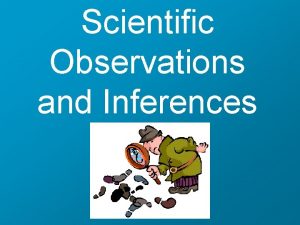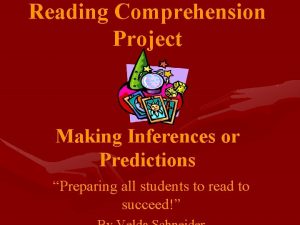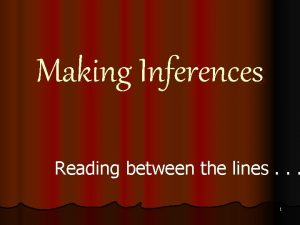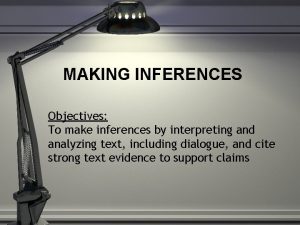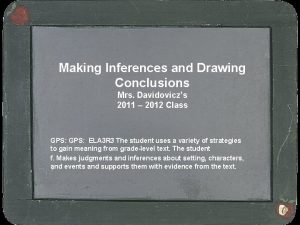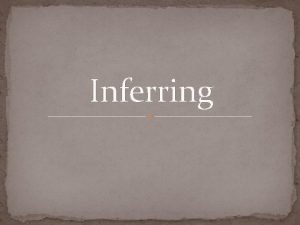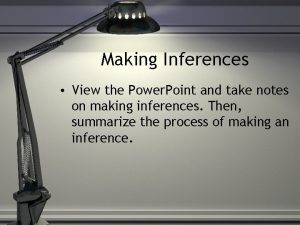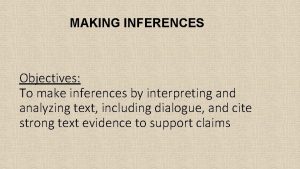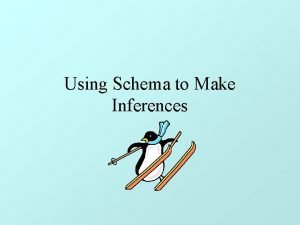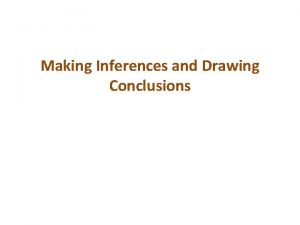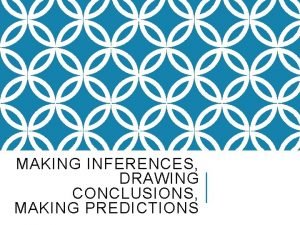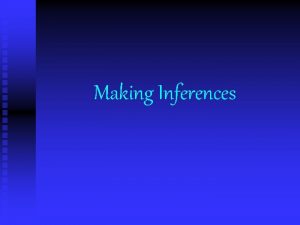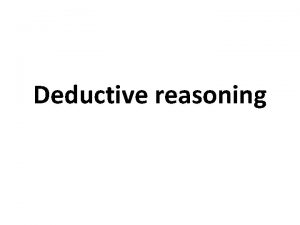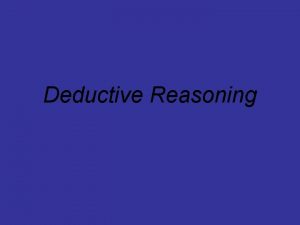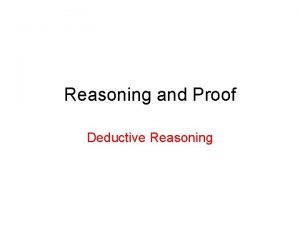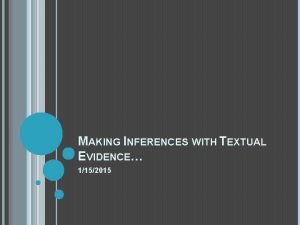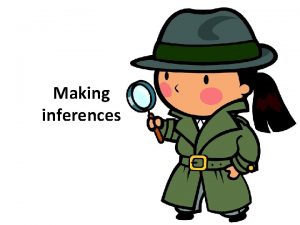Artificial Intelligence 7 Making Deductive Inferences Course V


























- Slides: 26

Artificial Intelligence 7. Making Deductive Inferences Course V 231 Department of Computing Imperial College, London Jeremy Gow

Automating Deductive Reasoning l Aims of automated deduction – – l Theorem proving – – l Deduce new knowledge from old Prove/disprove some open conjectures Search for a path from axioms to theorem statement Operators are (sound) inference rules Applications: – – Agents that use deductive inference Mechanising and automating mathematics Verifying hardware and software specifications The semantic web

Inference Rules l A entails B iff – – l l B is true when A is true Any model of A is a model of B Then this is a sound inference rule A B Axioms C D … Z Theorem – – Each step is application of inference rule Theorem is entailed by the axioms

Tautologies • S: (X (Y Z)) ((X Y) (X Z)) • Show that no matter what truth values for X, Y and Z • • The statement S is always true X Y Z X Y X Z X (Y Z) ((X Y) (X Z)) S true true true false false true false true false false true true true false true true false true true false true true Columns 7 and 8 are always the same

Inference with Tautologies l P Q Q P is obviously true – – l Regardless of meaning or truth values of P and Q This is content-free and a tautology One way to define a rule of inference: – – – We can replace P Q with Q P, and vice versa They are true for same models Replacing one for other preserves soundness

Equivalence Rules l A and B are logically equivalent (write A B) – – l Formalised as rewrite rule A B – – – l Same models for each Can replace any instance of A with an instance of B without affecting models Also B A Must avoid looping A B . . . Choose one direction, or always loop-check Rewrite rules used for inference – – Showing theorem and axioms are equivalent Preprocessing theorem/axioms into a particular format

Commutativity & Associativity l Commutativity P Q P Q l Q P P (Q R) Q P Associativity (P Q) R P (Q R)

Distributivity of Connectives l ‘and over or’ and ‘or over and’: P (Q R) l (P Q) (P R) Over implication P (Q R) (P Q) (P R)

Double Negation l Have to be careful in English – – l “I’m not hungry” Does not (necessarily) mean: “I’m hungry” But double negations can always be removed ¬¬P l P Humans would not write this – But it may appear in during agent’s inference

De Morgan’s Law & Contraposition l De Morgan’s Law (refers to either) ¬(P Q) l ¬P ¬Q Contraposition: imagine the opposite is true – P Q ¬P Often useful in mathematics proof

Other Equivalences l l Remove implication or equivalence (very useful) – P Q ¬P Q (P Q) (Q P) Reduce to truth value P ¬P False True

An Example Deduction (P Q) (¬P Q) l Show that this sentence is false – – l l Show that this rewrites to False This proves the negation See notes for solution (or do as exercise) Is this easier than a truth table?

Propositional Inference Rules l Rewrite rules are good for bidirectional search – l Classic example – – l All men are mortal, socrates is a man Therefore: Socrates is mortal This is an instance of an inference rule – l But we don’t need equivalence, just entailment Known as Modus Ponens (Aristotle) A B, A B Above line: what we know, below: what we can deduce

Soundness of Modus Ponens l Every model of top sentences is a model of the bottom sentence A True False B True False True A B Top: A B, A True False Bottom: B True False True

And-Elimination & -Introduction l And-Elimination: A 1 A 2 … A n Ai [1 i n] l And-Introduction: A 1, A 2, …, An A 1 A 2 … A n l The sentences may be from different places – Selected from the database

Or-Introduction & Unit Resolution l Or-introduction Ai A 1 A 2 … A n [1 i n] l Unit resolution (A B) , ¬B A l Basis for resolution theorem proving – See next two lectures

First-Order Inference Rules l Propositional inference rules (inc. equivs) – l l First-order inference more complicated Soundness depends on concept of models – l Can all be used in first-order inference Potentially infinite models, can’t use a truth table Sentences contain quantifiers – Need the notion of ground substitution

Substitution & Instantiation l FOL sentences have quantified variables – – l Instantiation (grounding) is a kind of substitution – l l Substitute into a variable by assigning a particular value Replace with given term, remove quantifier Must substitute a ground term Example: X. Y. likes(X, Y) becomes likes(tony, george) We write: – Subst({X/tony, Y/george}, likes(X, Y)) = likes(tony, george)

Universal Elimination l Given a sentence, A – – Containing a universally quantified variable V Then we can replace V by any ground term g V. A Subst({V/g}, A) l l Remember to remove quantifier Not as complicated as it looks: X likes(X, ice_cream) becomes likes(ben, ice_cream)

Existential Elimination l Given a sentence, A – – – Containing an existentially quantified variable, V Then we can replace V by any constant, k As long as k is not mentioned anywhere else V. A Subst({V/k}, A) l For the sake of argument, let’s call it…

Existential Introduction l Given a sentence, A – – And a variable, V, which is not used in A Then any ground term, g, in A can be substituted by V l As long as g does not appear in A also A V. Subst({g/V}, A) l Exercise: find sentence where V is in A – Such that this inference rule is not sound

Chains of Inference l Remember the problem we’re trying to solve – l Three approaches – – – l Search for a path from axioms, A, to theorem, T Forward chaining Backward chaining Proof by contradiction Specification of a search problem: – – Representation of states (first-order logic sentences) Initial state (depends. . . ) Operators (inference rules, including equivalences) Goal state (depends. . . )

Forward Chaining l Deduce new facts from axioms – l l Deduce new facts from these, etc. , … Hopefully end up deducing theorem statement Can take a long time: not using the goal to direct search A 1 T A 2 A 3

Backward Chaining l Start with theorem state and work backwards – l Each step asks: given the state that I’m at. . . – l Which operator could have been applied to which state to produce the state (sentence) I’m at No problem when using equivalences – l Hope to end up at the axioms Can also use a bidirectional search (from both ends) Difficult when using general inference rules – Many possible ways to invert operators

Proof By Contradiction l l “Reductio ad absurdum” Assume theorem is false – – l Add negated theorem to the set of axioms – l then show that the assumption contradicts the axioms which proves that theorem is true See if we can deduce the ‘False’ sentence Advantage: using theorem statement from start – Can look to see how close we are to the false statement l l Possibilities for a heuristic search! Basis for resolution theorem proving

Example: using the Otter resolution theorem prover Input to Otter: set(auto). formula_list(usable). all x (man(x)->mortal(x)). % For all x, if x is a man then x is mortal man(socrates). % Socrates is a man -mortal(socrates). % Socrates is immortal (note: negated) end_of_list. Output from Otter: -------- PROOF --------1 [] -man(x)|mortal(x). 2 [] -mortal(socrates). 3 [] man(socrates). 4 [hyper, 3, 1] mortal(socrates). 5 [binary, 4. 1, 2. 1] $F. ------ end of proof -------
 What are observations and inferences
What are observations and inferences Prediction vs inference venn diagram
Prediction vs inference venn diagram Making inferences reading between the lines
Making inferences reading between the lines Inference objectives
Inference objectives Drawing conclusions and making inferences powerpoint
Drawing conclusions and making inferences powerpoint Draw a conclusion example
Draw a conclusion example Character inferences
Character inferences What is making inferences in reading
What is making inferences in reading Making inferences examples
Making inferences examples Making inferences
Making inferences Making inferences powerpoint
Making inferences powerpoint Inference objectives
Inference objectives Essential questions for inferencing
Essential questions for inferencing Langston hughes thank you mam
Langston hughes thank you mam Making inferences reading strategy
Making inferences reading strategy Drawing conclusions meaning
Drawing conclusions meaning Making inferences drawing conclusions
Making inferences drawing conclusions Brainpop making inferences
Brainpop making inferences The components of expert system
The components of expert system State space search in artificial intelligence
State space search in artificial intelligence Searching for solutions in artificial intelligence
Searching for solutions in artificial intelligence 15-780 graduate artificial intelligence
15-780 graduate artificial intelligence Knowledge manipulation in artificial intelligence
Knowledge manipulation in artificial intelligence Types of knowledge
Types of knowledge Starts new page numbered sequentially
Starts new page numbered sequentially Kecerdasan kepemimpinan
Kecerdasan kepemimpinan Artificial intelligence assessment
Artificial intelligence assessment
